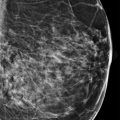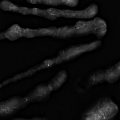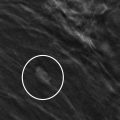Presentation and Presenting Images
A 68-year-old female presents for screening mammography.
45.2 Key Images
45.2.1 Breast Tissue Density
There are scattered areas of fibroglandular density.
45.2.2 Imaging Findings
In the upper outer quadrant in the posterior depth of the left breast, there is a focal asymmetry (seen on both full-field digital mammography [FFDM] and digital breast tomosynthesis [DBT]) with associated architectural distortion (which is best seen on the DBT). The focal asymmetry is best seen on the mediolateral oblique (MLO) views ( ▶ Fig. 45.2 and ▶ Fig. 45.4). It is at the very edge of the craniocaudal (CC) views ( ▶ Fig. 45.1 and ▶ Fig. 45.3), and better seen on the craniocaudal (CC) tomosynthesis image ( ▶ Fig. 45.3) compared to the conventional CC mammogram ( ▶ Fig. 45.1). The lateral location of the finding on the MLO DBT slices directs the reader to the corresponding finding in the lateral region on the CC view.
45.3 BI-RADS Classification and Action
Category 0: Mammography: Incomplete. Need additional imaging evaluation and/or prior mammograms for comparison.
45.4 Diagnostic Images
( ▶ Fig. 45.5, ▶ Fig. 45.6, ▶ Fig. 45.7, ▶ Fig. 45.8, ▶ Fig. 45.9, ▶ Fig. 45.10, ▶ Fig. 45.11, ▶ Fig. 45.12)
45.4.1 Imaging Findings
The diagnostic imaging demonstrates an 8 × 9 × 8 mm irregular mass with indistinct margins and architectural distortion at the 2 o’clock location in the posterior depth ( ▶ Fig. 45.5, ▶ Fig. 45.6, ▶ Fig. 45.7, and ▶ Fig. 45.8). Posterior to this mass is a circumscribed oval mass. This is an intramammary lymph node that has been stable for many years ( ▶ Fig. 45.7 and ▶ Fig. 45.8). The targeted ultrasound demonstrates a lesion that was found with great difficulty. On ultrasound ( ▶ Fig. 45.9 and ▶ Fig. 45.10), the mass is hypoechoic with indistinct margins and located near the chest wall. It is slightly smaller on ultrasound than on mammography, measuring 7 × 7 × 6 mm. Normal intramammary and low-level axillary lymph nodes were seen (not shown). The postprocedure mammograms ( ▶ Fig. 45.11 and ▶ Fig. 45.12) demonstrate the ribbon biopsy clip 3 mm lateral to the lesion.
45.5 BI-RADS Classification and Action
Category 4B: Moderate suspicion for malignancy
45.6 Differential Diagnosis
Breast cancer (invasive ductal carcinoma): This mass is new and irregular with indistinct margins. Those features alone would raise the suspicion for cancer. The indistinct margins on ultrasound also suggest an invasive process.
Lymph node: Although there are adjacent lymph nodes, this mass has features that suggest that if it is a lymph node, it will not be a normal lymph node. If an image-guided biopsy resulted in the diagnosis of a metastatic lymph node that would be considered concordant. The next step would involve finding the primary carinoma.
Focal fibrosis: Focal fibrosis can mimic cancer. An image-guided biopsy of this lesion should yield a histopathologic analysis of this discrete mass If focal fibrosis is the dominant feature of this mass, then this diagnosis is concordant. If a minority of the mass is focal fibrosis, then excision is recommended.
45.7 Essential Facts-
Similar to FFDM, positioning with DBT is extremely important. If the tissue of interest is not appropriately included on the mammogram, no assessment can be made of it.
Similar to FFDM, the posterior-nipple-line (PNL) depth of the tissue on the CC and MLO views should be within 1 cm on DBT.
Fat should be posterior to the fibroglandular tissue on both the CC and MLO views. Sometimes an additional exaggerated (XCC) view may be necessary on the screening mammography examination.
DBT has been shown to improve the specificity and sensitivity in breast cancer screening. The conspicuity of masses and areas of architectural distortion are improved with DBT.
Taplin and colleagues (2002) observed that that the detection of cancer was highest (84%) when the patients had proper positioning at mammography. This sensitivity falls to 66.3% when positioning is not correct.
In this case, the DBT images highlighted the finding on the conventional MLO mammogram as being suspicious. The finding is barely included on the conventional CC mammogram. Without DBT, this case might have been among the ones with a missed cancer.
45.8 Management and Digital Breast Tomosynthesis Principles
Improperly positioned FFDM and DBT can contribute to interval cancers. When the breast tissue is not properly positioned, cancers that were present can go undetected when not imaged.
Patients should be recalled for repeat imaging when there are technical factors that impede diagnostic interpretation. Some technical factors the can impede diagnosis are patient positioning and motion, radiation exposure (too much or too little) and breast compression (too little).
Lesions seen only on one view are one cause of missed cancers.
Posterior lesions are often a cause of missed cancers given that they may only be seen on one view, and not included on the orthogonal view.
45.9 Further Reading
[1] Conant EF. Clinical implementation of digital breast tomosynthesis. Radiol Clin North Am. 2014; 52(3): 499‐518 PubMed
[2] Taplin SH, Rutter CM, Finder C, Mandelson MT, Houn F, White E. Screening mammography: clinical image quality and the risk of interval breast cancer. AJR Am J Roentgenol. 2002; 178(4): 797‐803 PubMed

Fig. 45.1 Left craniocaudal (LCC) mammogram.
Stay updated, free articles. Join our Telegram channel

Full access? Get Clinical Tree








